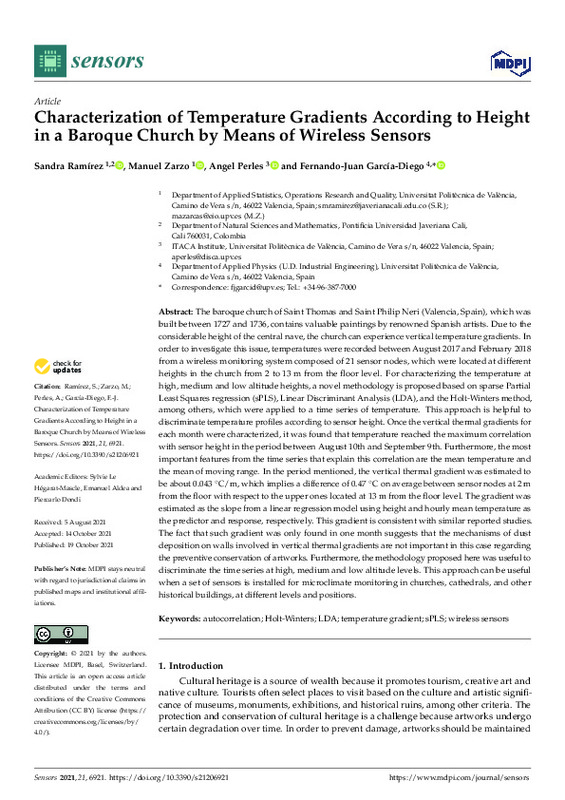JavaScript is disabled for your browser. Some features of this site may not work without it.
Buscar en RiuNet
Listar
Mi cuenta
Estadísticas
Ayuda RiuNet
Admin. UPV
Characterization of temperature gradients according to height in a baroque church by means of wireless sensors
Mostrar el registro sencillo del ítem
Ficheros en el ítem
| dc.contributor.author | Ramírez, Sandra
|
es_ES |
| dc.contributor.author | Zarzo Castelló, Manuel
|
es_ES |
| dc.contributor.author | Perles, Angel
|
es_ES |
| dc.contributor.author | García Diego, Fernando Juan
|
es_ES |
| dc.date.accessioned | 2022-05-12T18:06:42Z | |
| dc.date.available | 2022-05-12T18:06:42Z | |
| dc.date.issued | 2021-10 | es_ES |
| dc.identifier.uri | http://hdl.handle.net/10251/182569 | |
| dc.description.abstract | [EN] The baroque church of Saint Thomas and Saint Philip Neri (Valencia, Spain), which was built between 1727 and 1736, contains valuable paintings by renowned Spanish artists. Due to the considerable height of the central nave, the church can experience vertical temperature gradients. In order to investigate this issue, temperatures were recorded between August 2017 and February 2018 from a wireless monitoring system composed of 21 sensor nodes, which were located at different heights in the church from 2 to 13 m from the floor level. For characterizing the temperature at high, medium and low altitude heights, a novel methodology is proposed based on sparse Partial Least Squares regression (sPLS), Linear Discriminant Analysis (LDA), and the Holt-Winters method, among others, which were applied to a time series of temperature. This approach is helpful to discriminate temperature profiles according to sensor height. Once the vertical thermal gradients for each month were characterized, it was found that temperature reached the maximum correlation with sensor height in the period between August 10th and September 9th. Furthermore, the most important features from the time series that explain this correlation are the mean temperature and the mean of moving range. In the period mentioned, the vertical thermal gradient was estimated to be about 0.043 ºC/m, which implies a difference of 0.47 ºC on average between sensor nodes at 2 m from the floor with respect to the upper ones located at 13 m from the floor level. The gradient was estimated as the slope from a linear regression model using height and hourly mean temperature as the predictor and response, respectively. This gradient is consistent with similar reported studies. The fact that such gradient was only found in one month suggests that the mechanisms of dust deposition on walls involved in vertical thermal gradients are not important in this case regarding the preventive conservation of artworks. Furthermore, the methodology proposed here was useful to discriminate the time series at high, medium and low altitude levels. This approach can be useful when a set of sensors is installed for microclimate monitoring in churches, cathedrals, and other historical buildings, at different levels and positions. | es_ES |
| dc.description.sponsorship | This project received funding from the European Union's Horizon 2020 research and innovation program under grant agreement No. 814624. | es_ES |
| dc.language | Inglés | es_ES |
| dc.publisher | MDPI AG | es_ES |
| dc.relation.ispartof | Sensors | es_ES |
| dc.rights | Reconocimiento (by) | es_ES |
| dc.subject | Autocorrelation | es_ES |
| dc.subject | Holt-Winters | es_ES |
| dc.subject | LDA | es_ES |
| dc.subject | Temperature gradient | es_ES |
| dc.subject | SPLS | es_ES |
| dc.subject | Wireless sensors | es_ES |
| dc.subject.classification | ESTADISTICA E INVESTIGACION OPERATIVA | es_ES |
| dc.subject.classification | FISICA APLICADA | es_ES |
| dc.subject.classification | ARQUITECTURA Y TECNOLOGIA DE COMPUTADORES | es_ES |
| dc.title | Characterization of temperature gradients according to height in a baroque church by means of wireless sensors | es_ES |
| dc.type | Artículo | es_ES |
| dc.identifier.doi | 10.3390/s21206921 | es_ES |
| dc.relation.projectID | info:eu-repo/grantAgreement/EC/H2020/814624/EU | es_ES |
| dc.rights.accessRights | Abierto | es_ES |
| dc.contributor.affiliation | Universitat Politècnica de València. Departamento de Física Aplicada - Departament de Física Aplicada | es_ES |
| dc.contributor.affiliation | Universitat Politècnica de València. Departamento de Estadística e Investigación Operativa Aplicadas y Calidad - Departament d'Estadística i Investigació Operativa Aplicades i Qualitat | es_ES |
| dc.contributor.affiliation | Universitat Politècnica de València. Departamento de Informática de Sistemas y Computadores - Departament d'Informàtica de Sistemes i Computadors | es_ES |
| dc.description.bibliographicCitation | Ramírez, S.; Zarzo Castelló, M.; Perles, A.; García Diego, FJ. (2021). Characterization of temperature gradients according to height in a baroque church by means of wireless sensors. Sensors. 21(20):1-35. https://doi.org/10.3390/s21206921 | es_ES |
| dc.description.accrualMethod | S | es_ES |
| dc.relation.publisherversion | https://doi.org/10.3390/s21206921 | es_ES |
| dc.description.upvformatpinicio | 1 | es_ES |
| dc.description.upvformatpfin | 35 | es_ES |
| dc.type.version | info:eu-repo/semantics/publishedVersion | es_ES |
| dc.description.volume | 21 | es_ES |
| dc.description.issue | 20 | es_ES |
| dc.identifier.eissn | 1424-8220 | es_ES |
| dc.identifier.pmid | 34696134 | es_ES |
| dc.identifier.pmcid | PMC8540709 | es_ES |
| dc.relation.pasarela | S\447688 | es_ES |
| dc.contributor.funder | COMISION DE LAS COMUNIDADES EUROPEA | es_ES |
| upv.costeAPC | 2180 | es_ES |








